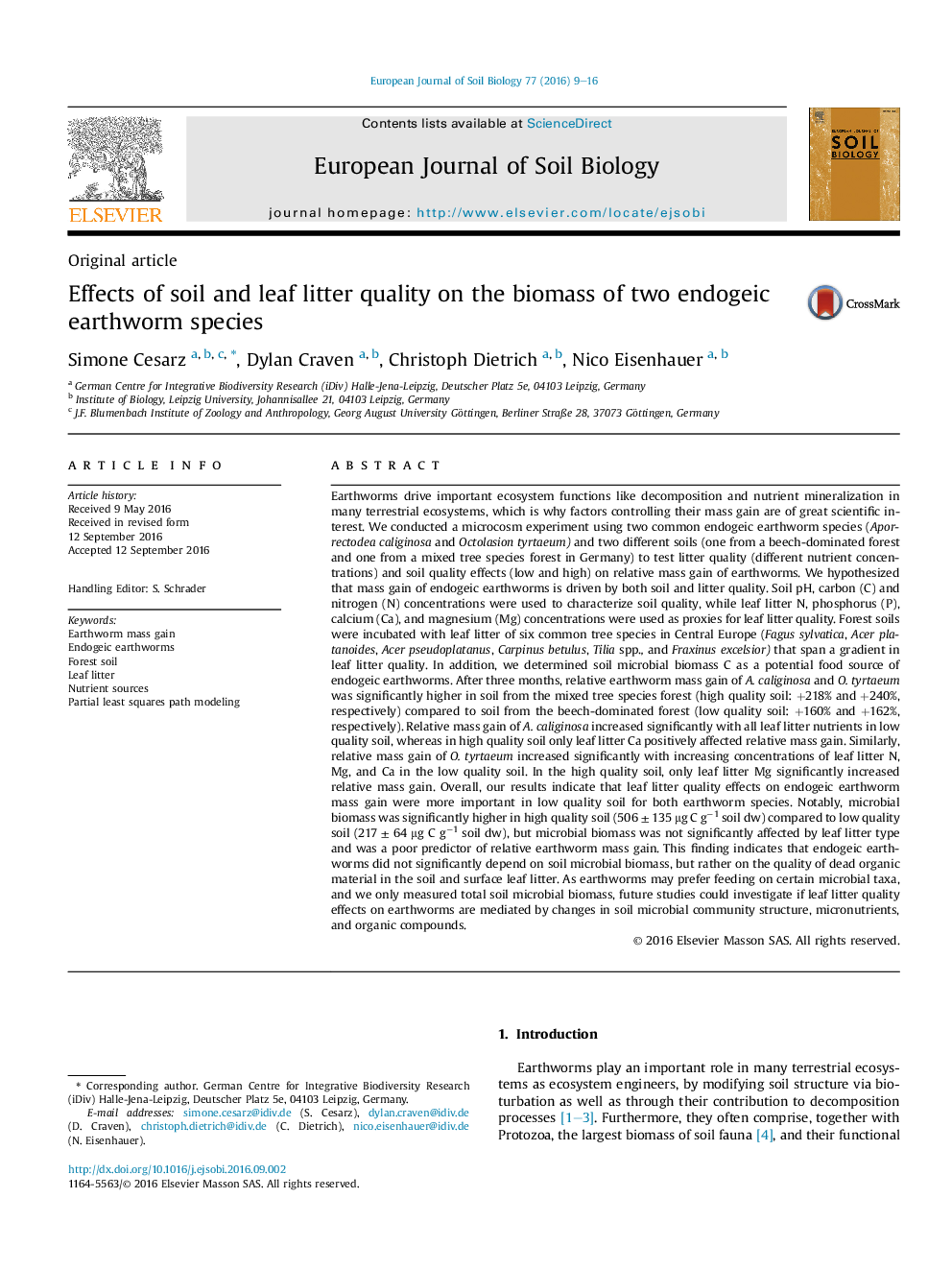| Article ID | Journal | Published Year | Pages | File Type |
|---|---|---|---|---|
| 4391621 | European Journal of Soil Biology | 2016 | 8 Pages |
•Interactions of leaf litter and soil quality were tested on endogeic earthworms.•PLS path modeling was used to separate inter-correlated explanatory variables.•Leaf litter quality effects dominated in soil of the nutrient-poor site.•Endogeic earthworms do not depend on microbial biomass but on leaf litter quality.
Earthworms drive important ecosystem functions like decomposition and nutrient mineralization in many terrestrial ecosystems, which is why factors controlling their mass gain are of great scientific interest. We conducted a microcosm experiment using two common endogeic earthworm species (Aporrectodea caliginosa and Octolasion tyrtaeum) and two different soils (one from a beech-dominated forest and one from a mixed tree species forest in Germany) to test litter quality (different nutrient concentrations) and soil quality effects (low and high) on relative mass gain of earthworms. We hypothesized that mass gain of endogeic earthworms is driven by both soil and litter quality. Soil pH, carbon (C) and nitrogen (N) concentrations were used to characterize soil quality, while leaf litter N, phosphorus (P), calcium (Ca), and magnesium (Mg) concentrations were used as proxies for leaf litter quality. Forest soils were incubated with leaf litter of six common tree species in Central Europe (Fagus sylvatica, Acer platanoides, Acer pseudoplatanus, Carpinus betulus, Tilia spp., and Fraxinus excelsior) that span a gradient in leaf litter quality. In addition, we determined soil microbial biomass C as a potential food source of endogeic earthworms. After three months, relative earthworm mass gain of A. caliginosa and O. tyrtaeum was significantly higher in soil from the mixed tree species forest (high quality soil: +218% and +240%, respectively) compared to soil from the beech-dominated forest (low quality soil: +160% and +162%, respectively). Relative mass gain of A. caliginosa increased significantly with all leaf litter nutrients in low quality soil, whereas in high quality soil only leaf litter Ca positively affected relative mass gain. Similarly, relative mass gain of O. tyrtaeum increased significantly with increasing concentrations of leaf litter N, Mg, and Ca in the low quality soil. In the high quality soil, only leaf litter Mg significantly increased relative mass gain. Overall, our results indicate that leaf litter quality effects on endogeic earthworm mass gain were more important in low quality soil for both earthworm species. Notably, microbial biomass was significantly higher in high quality soil (506 ± 135 μg C g−1 soil dw) compared to low quality soil (217 ± 64 μg C g−1 soil dw), but microbial biomass was not significantly affected by leaf litter type and was a poor predictor of relative earthworm mass gain. This finding indicates that endogeic earthworms did not significantly depend on soil microbial biomass, but rather on the quality of dead organic material in the soil and surface leaf litter. As earthworms may prefer feeding on certain microbial taxa, and we only measured total soil microbial biomass, future studies could investigate if leaf litter quality effects on earthworms are mediated by changes in soil microbial community structure, micronutrients, and organic compounds.
